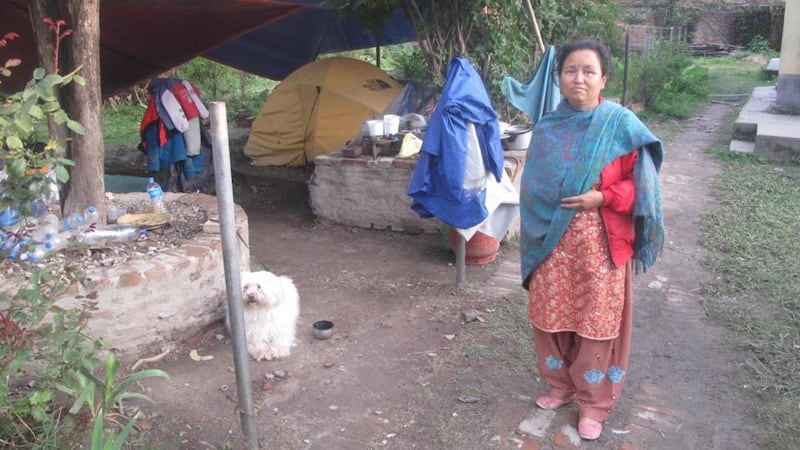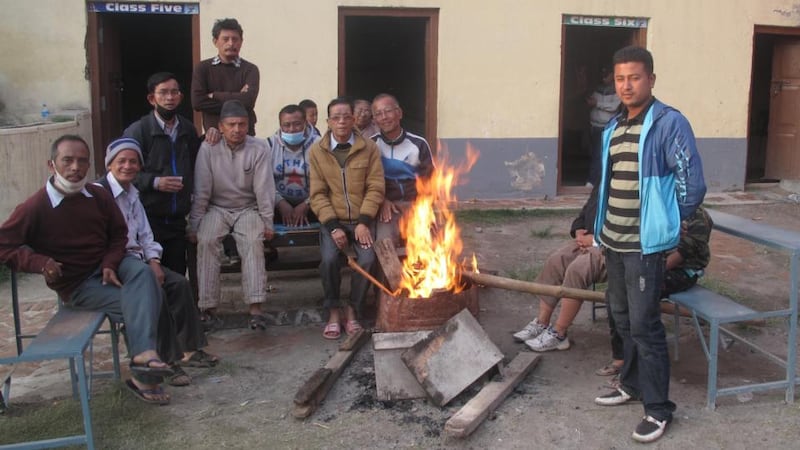There are people still in the ruins, all over Kathmandu, they just haven't been unearthed yet. It's a common refrain in the Nepali capital, four days after Saturday's catastrophically powerful 7.8 magnitude earthquake.
In the city, beside the 19th century Dharahara tower, a man in a Barcelona FC shirt says the bodies are still below.
“We will rebuild it,” he said. “This means too much for us Nepalis. But the dead are still in there.”


There is an uneasy feeling. People are taking photos, documenting something too gruesome to contemplate.
Fruit vendors were back on the streets selling produce, and the mobile phone shops were opening again, a sign that things were returning to normal. But widespread fear about the “cracks”, and whether the earthquake damage means your house could fall on your head at any moment, lingers like a curse.
The bricks on the wall outside the supreme court have fallen on to the street, while the attorney general’s office is similarly denuded. Convoys of SUVs, sirens blaring, zip through the congested streets, bringing aid to the parts of the city still digging out bodies.
Leaning precariously
There are tents on the green areas dividing the roads. There are tents on the roundabouts in the city. Some buildings lean precariously sideways. My driver, Gupti, tells me how his house has collapsed, but they are just happy that everyone survived. But what now? he asks. What now?
Gupti says the key is whether your house had steel beams or not. If it didn’t, then you have a big problem to deal with.
The toll that this earthquake has taken on the fabric of Nepali society is immense.
The spectacular 17th-century Pashupatinath temple on the banks of the Baghmati river, a Unesco World Heritage site, has become a crematorium.
In the shops, no one has raised prices and the taxi drivers have scrupulously kept their fares at the same level. People thank you for coming here as a journalist and for letting the world know what has happened to Nepal.
Rebuilding is a challenge because the rainy season is coming and the materials will take time to arrive. And the cold winter comes hard on the heels of the spring, so they need to do something.
Nepal is like Ireland in the way that many young people go abroad to work because the domestic economy is slow. One guesthouse which provided accommodation for hundreds of migrant workers was destroyed. Most of the workers were men, and their wives gathered around wondering what they would do now.
The number of confirmed deaths has risen above 5,000, with almost 10,000 injured in Nepal, while more than 80 were also killed in India and Tibet.
Eight million affected
About eight million Nepalese have been affected by the earthquake, including 1.4 million needing immediate food assistance.
Bhaktapur, on the outskirts of Kathmandu, and about 50km from the epicentre, translates as “the place of devotees”, an ancient city on the eastern side of the valley and a former capital of Nepal. Its temples and courtyards are legendary, but the city has been devastated by the tremor.
Here people still believe there are bodies buried under Bhaktapur Durbar Square, and the search continues, while survivors try to piece together what they can from the devastation.
"Most of the people who weren't from here have gone back home, around 50 per cent of them. Most of the rest who came here to work will leave soon. We are living in tents but we will move home," said Bijan Tamrakar, who works transporting food from the market in the main durbar (royal square).
“At least 50 or 60 per cent of people here in Bhaktapur were affected by the quake. At least 250 people are dead,” said Tamrakar.
With the death toll expected to reach 10,000, and with information on casualties and damage from far-flung villages and towns yet to come in, the final figure looks set to surpass the 8,500 who died in a 1934 earthquake, the last disaster on this scale to hit the Himalayan nation of 28 million people located between India and China.
The Shiva Vairafnat temple survived the quake but, in the lanes nearby, there are bodies still being dug out of the wreckage of traditional buildings, constructed using the brick style fronted by wooden shutters, that appears not to have been able to withstand the tremor.
Bhaktapur shuddered in the 1934 quake, which destroyed many of the elegant buildings in the city. Some of the city’s key buildings, including the Five Stove temple on the durbar royal square, still stand, its layers of pagodas intact and its lions and elephants still standing guard.
Tara Tamrakar was in her uncle’s house near Bhaktapur Durbar Square when the quake stuck. “I fell down, then a wall fell on me, bricks fell on my head. I have pains in my legs and I have these marks on my forehead. I am taking medicine,” she said, pointing to a cut on her head.
Tamrakar has two children in their 30s. “My relatives didn’t know where I was. My brother and son rescued me, they found me unconscious,” she said.
Two bodies
Chinese rescue teams have been high-profile in the relief works.
“We found two bodies here in Bhaktapur today,” said David Chi, the local commander of the Chinese aid group Blue Sky Rescue.
“We brought 50 or 60 people here and we are using helicopters to see what damage has been done. We’ve been working closely with Dutch aid groups. Our focus is on immediate rescue, but after 72 hours, the chances of finding people alive is limited,” said Chi.
There are, of course, exceptions, said Chi.
A Nepali-French search-and-rescue team pulled a 28-year-old man, Rishi Khanal, from a collapsed apartment block after he had spent about 80 hours in a room with three dead bodies.
The drive back to the city takes you along streets lined with tents. At some points, the road has been cleaved in two by the quake, with one side elevated several feet higher than the other.
In the tent city building up in Kathmandu’s Dasarath stadium, Aran Khanal (15) is worried about what comes next.
“I am from a village, and working here in Kathmandu for the last five years. All my family is safe, but our house is cracked. There has been great help from outside. And the army have been a great help. We need blankets. We get a cup of tea and six biscuits for breakfast. And one bottle of mineral water,” he said.
The city is filled with relief workers, all looking for ways to get to the worst-affected areas.
At the Shiva Guesthouse in Bhaktapur, the toilet sign is written in Irish – leithreas.
Asked how things are, the owner says he is busy trying to rebuild his business.
“What can I say? We are still alive. We are lucky. But look around you, what a mess.”








